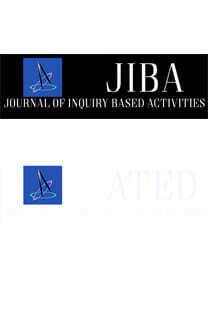AN ACTIVITY DESIGN FOR STUDENTS WITH VISUAL IMPAIRMENT: WHAT IS ELECTRICAL FUSE?
GÖRME YETERSİZLİĞİ OLAN ÖĞRENCİLERE YÖNELİK BİR ETKİNLİK TASARIMI: SİGORTA NEDİR?
___
- Altıntaş, G. E. (1998). İlköğretim okulları 4. sınıf fen bilgisi öğretiminde araç-gereç (deney yaprakları) ve bulmaca tekniğinin öğrencilerin akademik başarısına katkısı [The Contribution of the materials (experiment papers) and puzzle technique to academic success for fourth grade sciene teaching in primary schools] (Unpublished master’s thesis). Pamukkale Üniversitesi, Denizli.
- Boyd-Kimball, D. (2012). Adaptive instructional aids for teaching a blind student in a nonmajors college chemistry course. Journal of Chemical Education, 89(11), 1395-1399.
- Buultjens, M., Aitken, S., Ravenscroft, J., & Carey, K. (1999). Size counts: The significance of size, font and style of print for readers with low vision sitting examinations. British Journal of Visual Impairment, 17(1), 5-10.
- Bülbül, M. S., & Eryilmaz, A. (2010). How does a blind student measure three basic units in mechanics. Book of Abstracts of the 27th International Physics Congress (p. 352), Istanbul, Turkey.
- Bülbül, M.Ş. (2013). Görme engelli öğrenciler ile grafik çalışırken nasıl bir materyal kullanılmalıdır? [What kind of material should be used when studying graphs with visually impaired students?]. Fen Eğitimi ve Araştırmaları Derneği Fen Bilimleri Öğretimi Dergisi, 1(1), 1-11.
- Bülbül, M.Ş., Garip, B., Cansu, Ü., & Demirtaş, D. (2012). Görme engelliler için matematik öğretim materyali tasarımı: İğneli sayfa [Mathematics instructional materials designed for visually impaired students : Needle page]. İlköğretim Online, 11(4), 1-9.
- Cole, R. A., & A. J. Slavin, (2013). Use of a video assistive device in a university course in laboratory science: A case study. Journal of Visually Impairment and Blindness, 107(4), 311-315.
- Cooperman, S. (1980). Biology for the visually impaired student. The American Biology Teacher, 42(5), 293-304.
- Goudiras, D.B., Papadopoulos, K.S., Koutsoklenis, A.C., Papageorgiou V.E., & Stergiou, M.S. (2009). Factors affecting the reading media used by visually impaired adults. British Journal of Visual Impairment, 27(2), 111-127.
- Gupta, H. O., & Singh, R. (1998). Low-cost science teaching equipment for visually impaired children. Journal of Chemical Education, 75(5), 610-612.
- Karakoç, T. (2016). Görme yetersizliği olan öğrencilerin araştırmaya dayalı öğrenme yaklaşımı modellerinden rehberli keşfetme modelinin deneysel işlemleri kazanmalarına, akademik başarılarına ve fen bilgisine ait tutumlarına etkisi [The Contribution of guided discovery model of inquiry-based approach to visually impaired students acquisition of experimental procedures, academic success and attitudes towards sciences] (Unpublished dissertation). Gazi Üniversitesi, Eğitim Bilimleri Enstitüsü, Ankara.
- Kumar, D.D., Ramasamy, R., & Stefanich, G.P. (2001). Science instruction for students with visual impairments. ERIC Clearinghouse for Science, Mathematics, and Environmental Education, 2-4.
- Mason, H.L. (1999). Blurred vision: A study of the use of low vision aids by visually impaired secondary school pupils. British Journal of Visual Impairment, 17(3), 94-97.
- Masoodi, B., & Ban, J. R. (1980). Teaching the visually handicapped in regular classes. Eductional Leadership, 351-355.
- Mayo, P. M., (2004). Assessment of the impact chemistry text and figures have on visually impaired students' learning (Unpublished dissertation). Purdue University, West Lafayette, Indiana.
- McCallum, D., & Ungar, S. (2003). An introduction to the use of inkjet for tactile diagram production. The British Journal of Visual Impairment, 21(73).
- Neely, M. B. (2007). Using technology and other assistive strategies to aid students with disabilities in performing chemistry lab tasks. Journal of Chemical Education, 84(10), 1697-1701.
- Pereira, F., Aires-de-Sousa, J., Bonifácio, V. D., Mata, P., & Lobo, A. M. (2010). MOLinsight: A web portal for the processing of molecular structures by blind students. Journal of Chemical Education, 88(3), 361-362.
- Poon, T., & Ovadia, R. (2008). Using tactile learning aids for students with visual impairments in a first-semester organic chemistry course. Journal of Chemical Education, 85(2), 240-242.
- Ratliff, J., L. (1997). Chemistry for the visually impaired. Journal of Chemical Education, 74(6), 710.
- Rooks, D. L. (2009). Science for all: Experiences and outcomes of students with visual impairment in a guided inquiry-based classroom (Unpublished dissertation). The University of Arizona, Arizona.
- Sözbilir, M., Gül, Ş., Okcu, B., Yazıcı, F., Kızılaslan, A., Zorluoğlu, S. L., & Atila, G. (2015). Görme yetersizliği olan öğrencilere yönelik fen eğitimi araştırmalarında eğilimler [Trends in research papers about teaching science to visually impaired students]. Abant İzzet Baysal Üniversitesi Eğitim Fakültesi Dergisi, 15(1), 218-241.
- Supalo, C. (2005). Techniques to enhance instructors’ teaching effectiveness with chemistry students who are blind or visually impaired. Journal of Chemical Education, 82(10), 1513-1518.
- Weems, B. (1977). A physical science course for the visually impaired. The Physics Teacher, 15, 333-338.
- Yaşar, Ş. (2001). Öğretimde araç-gereç kullanımı [Using materials in teaching]. In M. Gültekin (Ed.), Öğretimde planlama ve değerlendirme (ss. 143- 160). Eskişehir: Anadolu Üniversitesi Açıköğretim Fakültesi Yayınları.
- ISSN: 2146-5711
- Yayın Aralığı: 2
- Başlangıç: 2011
- Yayıncı: Mustafa ÇAKIR
A NATURAL SELECTION ACTIVITY TO MOBILIZE SCIENTIFIC CREATIVITY: CLIPPY ISLAND
NERMİN BULUNUZ, MIZRAP BULUNUZ
AN ACTIVITY DESIGN FOR STUDENTS WITH VISUAL IMPAIRMENT: WHAT IS ELECTRICAL FUSE?
SOSYAL BİLGİLER DERSİNDE ZAMAN KAPSÜLÜ UYGULAMASI
Nermin BULUNUZ, Mızrap BULUNUZ
GÖRME YETERSİZLİĞİ OLAN ÖĞRENCİLERE YÖNELİK BİR ETKİNLİK TASARIMI: SİGORTA NEDİR?
GÖSTERİP YAPTIRMA TEKNİĞİ İLE GEOMETRİK CİSİM MODELLERİ YAPMA
BİLİMSEL YARATICILIĞI HAREKETE GEÇİRMEYE YÖNELİK BİR DOĞAL SEÇİLİM ETKİNLİĞİ: TOKA GAGALILAR ADASI
BUILDING THREE-DIMENSIONAL GEOMETRIC SOLID MODELS THROUGH DEMONSTRATION-PERFORMANCE METHOD
